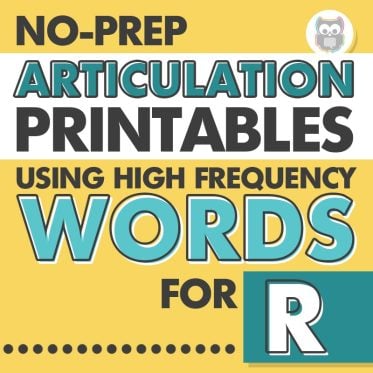What Does Pushing In Even Mean?
Push-in speech therapy is a collaborative classroom-based service delivery model. Basically, instead of pulling kids out of class to come to another location (like a speech room or maybe even in the hallway), the SLP is going into the classroom to work with the kids in their natural environment.
This can be implemented a few different ways, with the SLP teaching or co-teaching the lesson to the entire class, working with small groups in the classroom, working with students 1:1 at their desks, or just floating in the classroom to help the speech impaired students as needed.
Why the Push for Push-In Speech Therapy?
In the schools, we want to make sure our students are in the least restrictive environment. In fact, the Individuals with Disabilities Act mandates that we only take students out of their regular classroom when supplementary aids and services can’t successfully be addressed in that environment.
We also have to remember that the purpose of our therapy is to make sure students are successful in their classrooms.
And so, the push for push-in speech therapy began. Keeping students in their classrooms is clearly less restrictive (not to mention less disruptive!)
And yet, speech therapists report that they use pull-out speech therapy sessions 4 times as much as they use the push-in model (Green, Chance, & Stockholm, 2019).
Why the disparity?
Is pull-out speech therapy even effective?
The Evidence for Push-in Speech Therapy
One 2010 systematic analysis could only find 5 studies that examined inclusion service models, with some lower levels of evidence, concluding that we actually can’t conclude anything about push-in speech therapy (Cirrin, et al., 2010). The researchers ultimately conclude that we need to base our decisions on reason, as opposed to evidence until the evidence base improves (Cirrin, et al, 2010).
We do know that pushing into the classroom can provide a method of coaching for teachers who maybe have not received training in speech and language areas. One research study found that preschool teachers significantly improved in their teaching of early literacy skills, such as vocabulary, phonological awareness, and complex language when modeled by SLPs during co-teaching sessions (Terrell & Watson, 2018).
An SLP could push-in to the room and integrate phonological awareness activities in the room, such as talking about what sound a word starts with during class discussion, or provide differentiated instruction by working with a small group in the classroom who are struggling.
There is just a tiny bit more evidence about the use of curriculum-based language intervention. These interventions could be carried out in a pull-out speech therapy session, but probably involves even more planning and cooperation from teachers ahead of time to make sure you have the materials you need.
Several studies discuss how SLPs can support mathematic instruction for ELLs and nonmainstream American dialect speakers (anyone out there who is familiar with “New Math” know that there is a LOT of language involved in math these days!) (Newkirk-Turner & Johnson, 2018). When you are part of the math classroom, you can help clarify pronouns, teach meanings of morphemes, words, and phrases, or provide visuals for better comprehension. Speech therapists are qualified in helping teachers simplify language, without sacrificing math skills, especially for students with language impairments or differences.
Research tells us that we need to focus on the classroom materials if we want our students’ skills to generalize to the classroom. We can’t just teach them isolate skills and hope they figure out how to use them in the classroom on their own. I highly recommend checking out this article for ideas on how to use the curriculum to target reading strategies, oral and written language, higher level language, articulation and phonics.
This is my first post in a three-part series covering push-in therapy. Next week I’ll talk more about how my school made it all work!
{thanks for reading}
References
Cirrin, F., Schooling, T., Nelson, N., Sylvia, D., Flynn, P, Staskowsi, M., Torrey, T, & Adamczyk, D. (2010). Evidence-based systematic review: Effects of different service delivery models on communication outcomes for elementary school-age children. Language, Speech, and Hearing Services in Schools. https://doi.org/10.1044/0161-1461(2009/08-0128)
Green, L., Chance, P. & Stockholm, M. (2019). Implementation and perceptions of classroom-based service delivery: A survey of public school clinicians. Language, Speech, and Hearing Services in Schools. https://doi.org/10.1044/2019_LSHSS-18-0101
Newkirk-Turner, B. & Johnson, V. (2018). Curriculum-based language assessment with culturally and linguistically diverse students in the context of mathematics. Language, Speech, and Hearing Services in Schools. https://pubs.asha.org/doi/10.1044/2017_LSHSS-17-0050
Terrell, P., & Watson, M. (2018). Laying a firm foundation: Embedding evidence-based emergent literacy practices into early intervention and preschool environments. Language, Speech, and Hearing Services in Schools. https://doi.org/10.1044/2017_LSHSS-17-0053





















Leave a Comment